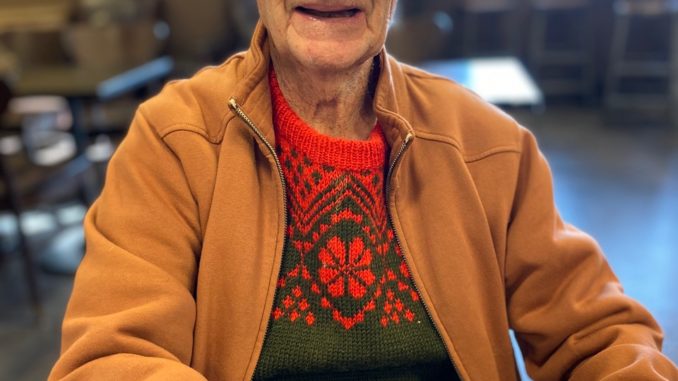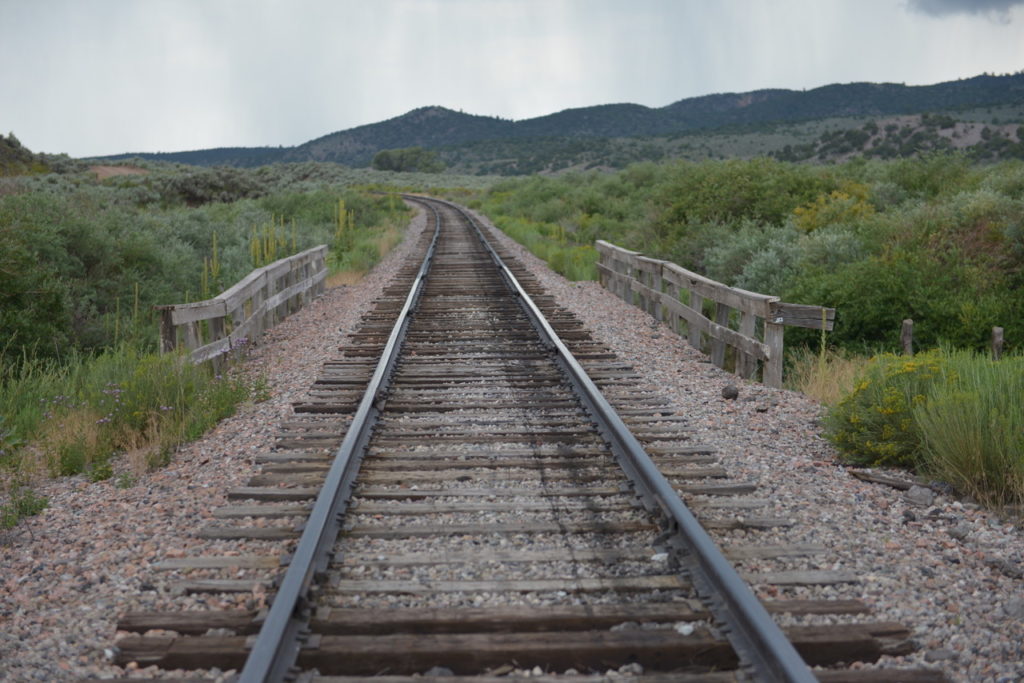
By Laura Mahal
What if a gandy dancer lived in your midst and you didn’t know it? Such is the case with a ninety-two-year old man, most recognizable for walking his very large Goldendoodle, Buddy. Yet few people in the neighborhood are aware of Ron Shriner’s time as a gandy dancer, working on the railroads of southern Colorado more than seventy-five years ago.
Before the upkeep of railway lines became mechanized, men known as “gandy dancers” maintained ties and rails to ensure the railroads ran smoothly. Gandy dancers would often sing or chant while they laid ties, set and aligned rails, and drove spikes into place.
Ron Shriner was a gandy dancer in the summers of 1944 and 1945, along with several of his friends from North Denver High School. They worked on a bridge gang out of Walsenburg, Colorado. Shriner’s crew maintained the tracks from Alamosa to Fort Garland every Monday through Saturday.
“Boy, you were really tired. That was hard work,” said Shriner. After working from 8 a.m. until 6 p.m., with a short break for lunch, the men often went to bed right after dinner. Occasionally, they’d explore nearby streams and do a little fishing. All it took to catch a trout was to “stick a worm on a pin.”
Crews rode to work in track cars and slept in the “smoker” car at night. They earned room and board and had their own cook, who was the only female. Breakfast consisted of eggs, bacon, and coffee. For dinner, they’d have fried chicken, along with mashed potatoes and gravy. On occasion, steak. It was tasty, said Shriner, who added: “[The] steak lasted a long time. You had to chew it all day.”

The lever used to keep tracks aligned was referred to as a “gandy.” The spoon-shaped end was wedged underneath a railroad tie. A man would bounce on the gandy to loosen the tie so others could shove ballast—sand, earth, and gravel—underneath. The ideal gandy dancer weighed 185 pounds, heavy enough to bend the spoon and not “fly off the handle.”
At age sixteen, Ron Shriner was too slight to take on this job. Instead, Shriner and his section crew handled freshly creosoted timbers for bridges. Creosote attracted heat. The foreman insisted the crew wear shirts, as the peril of not wearing one was a horrible sunburn. Jeans and heavy gloves were a necessity, and some men wore caps. But they didn’t wear sun protection, which was unheard of at the time.
Shriner said it was the kind of job that “put hair on your brisket. You really learned the value of a dollar.” Gandy dancers earned between sixty cents and one dollar an hour in 1945.
Smaller bridges required frequent repairs from men such as Shriner. Specially trained drivers operated large rigs for bigger bridges. Yet the cranes and pile–driver machines often broke down. When that happened, crews placed four-hundred-pound timber planks by hand. Six men worked together, using metal tongs to clamp around and transport the timber. The men sang to make the hot, difficult work pass more quickly, and to time the lifting of ties and throwing of ballast.
Shriner broke into snippets of bawdy songs, some from his gandy-dancing days, some from his time as a Marine during World War II and Korea.
“You’re a drunkard and you’re not going to heaven, chug a lug, chug a lug.”
He clarified that there “was as much cussing and dirty jokes as there was singing. You’d hear some jokes that made your ears burn.”
On Saturday nights, Shriner and his high-school buddies flagged down the local express from Alamosa. This northbound train stopped in Pueblo for one hour to unload mailbags, then arrived in Denver at 2 a.m. The boys caught a few hours of sleep at their parents’ homes, before spending Sunday at Elitch Gardens. In the 1940s, the amusement park still attracted well-known performers such as the Glenn Miller Orchestra, Benny Goodman, Artie Shaw, and the Andrew Sisters. Lionel Barrymore and Helen Hays were both known to visit the famous Trocadero ball room. Between the dance hall, gardens, and rides, the boys spent much of their paychecks there. They returned to Southern Colorado on the 4 p.m. train.
Gandy dancing was hard work, no doubt, but Shriner has fond memories of the job, open to young men, as well as more seasoned laborers. If you can find a video of men singing while working on the railroads, you might gain a sense of the appeal of this job, now retired to the annals of history.
Support Northern Colorado Journalism
Show your support for North Forty News by helping us produce more content. It's a kind and simple gesture that will help us continue to bring more content to you.
BONUS - Donors get a link in their receipt to sign up for our once-per-week instant text messaging alert. Get your e-copy of North Forty News the moment it is released!
Click to Donate
